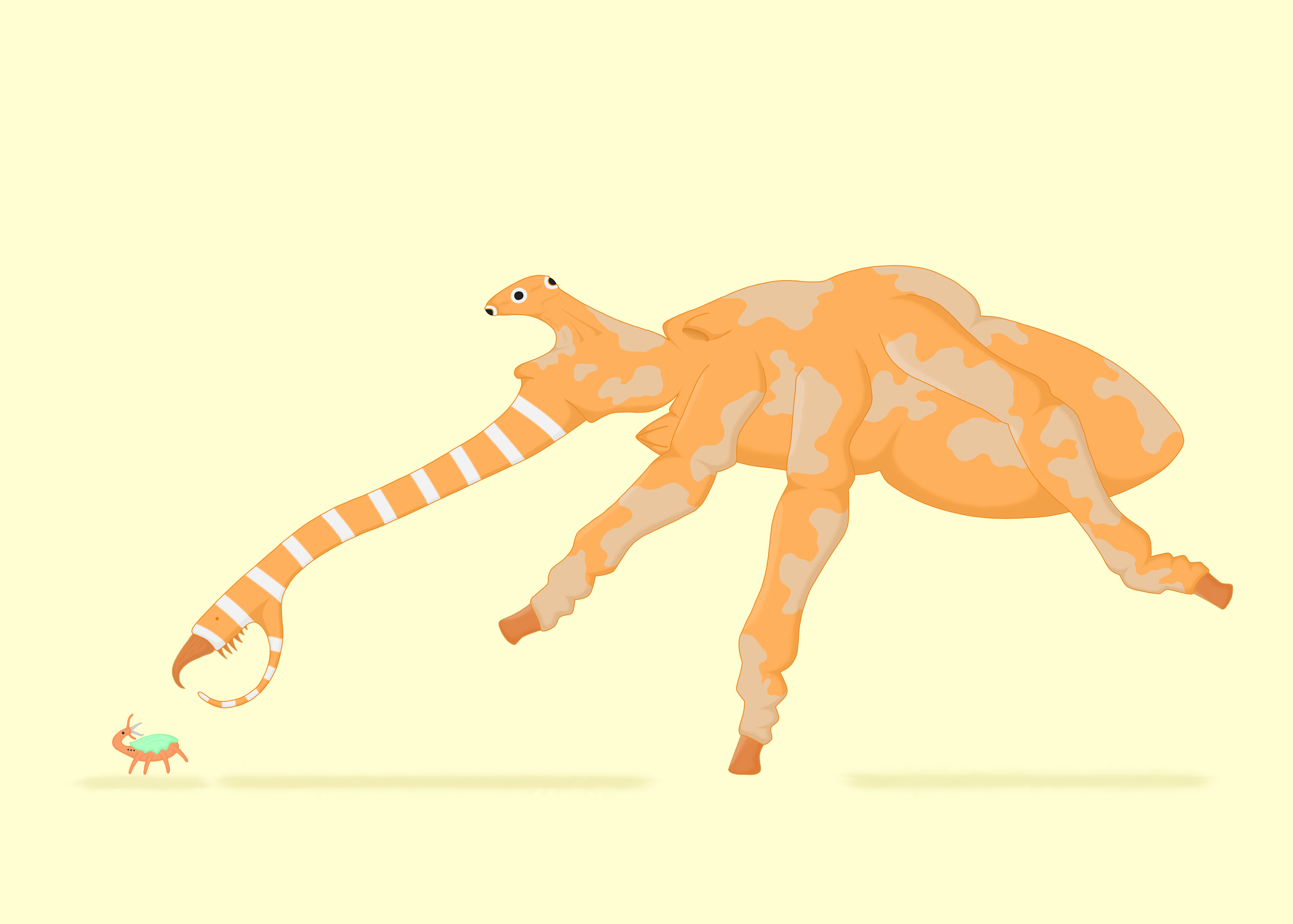HOME | DD
 Sorroxus — Choromestrisipod Pyknos
Sorroxus — Choromestrisipod Pyknos

#alien #aliencreature #aliendesign #alienworld #creature #creaturedesign #digitalart #specbio #specevo #exobio #stithopod
Published: 2021-10-27 11:20:50 +0000 UTC; Views: 2140; Favourites: 24; Downloads: 2
Redirect to original
Description
scientific name: chorometrisipod pyknos
common name: mottled squirt-bug
average height: ~1 foot
average weight: ~12 lbs
Life on Endos is old, with estimates putting complex multicellular life having existed for around 800 million years. Life in the oceans has been around far longer than on land, as life originally got its footing in the water, similar to life on Earth. In comparison, life on land has been around for considerably less time, with fully terrestrial life having been around for about only 242,000,000 years, as our estimates put it. With that knowledge, it should be no surprise that Endos has undergone multiple extinctions. In total, Endos has gone through five mass extinctions—the first occurred in the oceans before life had invaded land, then a second one occurred due to catastrophic volcanic activity, which devastated ecosystems both on land and in the water, which wiped out many primitive stithopods, then, after the rise of the osteopod polypods, which lasted about 102 million years, an ice age eventually led to a third mass extinction, nearly wiping out all osteopods except for a couple species, which could never take back their world, which then gave rise to more advanced stithopods who lived in the shadows of the giant osteopods, only to have a meteor crash into the planet, which wreaked havoc on life and completely decimated the world, which then opened the door for a small set of smaller stithopods to take the throne of the dominant lineage. The fifth mass extinction came for this group of stithopods in the form of another ice age, which killed off much of the plant life and animal life. However, as the world recovered, this class of stithopod managed to cling to their niche, and they quickly diversified once more, allowing them to reign again, making them the only group of animal to fully retake their niches after an extinction level event. Ever since that point, the class of stithopods known as Dyocardia (two hearts) has been the dominant clade of stithopods, identified by the two-heart system, which is connected to a main “pseudo-heart.” The other clade of stithopods that formerly held the title of dominant lineage is referred to as the class Monocardia (single heart), which is identified by the presence of a single heart.
Regardless, the Monocardians now live in the shadows of those they once towered over—the Dyocardians. Now, they are restricted to small, unsuspecting niches, with many not growing to be taller than two feet, though exceptions exist, with many being found on the islands of the world.
The Chorometrisipod Pyknos is a small, unsuspecting generalist omnivore that inhabits the frag forests of Concordia, just north of the western steppe. It is a species of the genus Chorometrisibrachium (surveying arms), a genus of the family Zitonbrachidae (seeker arms), one of the many families of the order Drepanibrachia (sickle arm). Among the bushes and lamaphytes, the Chorometrisipod skitters about, its eyes, mounted on an odd, long, telescope-like protrusion of bone, constantly surveying the surroundings, both to find prey and to make sure it does not become prey. Here, in the frag forests, it looks for small sarcoforme and testapod polypods to catch with its long, dexterous trunk, tipped with a large claw and smaller teeth-like claws underneath, along with a prehensile lower tentacle, which it uses in tandem to catch hold of the small prey, its smaller claws underneath cutting and slicing as the prey tries to escape.
In the event it cannot find food, which is unlikely, or if it sees the opportunity to, it will scavenge for dead meat, using olfactory pits on the tip of the small “finger” to survey for fresh spots on the carcass. Once it has located good meat, it will bore into the carcass with its large claw and use the rasping claws underneath to rip off chunks of meat.
Other times, it will choose to feed on some of the lampaphytes or fruit-like plants, with their stomachs able to extract as much sugar and nutrients as possible, which helps it to maintain high levels of energy throughout the waking hours.
Common predators of the C. Pyknos include the local Prionodactyls, local Leptognathids and sometimes other Chorometrisipods, which have been observed to regularly cannibalize each other, often with the stronger one tearing the other to shreds with its clawed arm. To counter predation, they have evolved to run relatively quickly, though this speed can only be kept for a few seconds before it eventually tires out. They often stick close to the small holes they dig, which they will seek refuge in if they are being chased down. Another more offensive form of defense is the noxious liquid they can shoot out of their behind from a small pore, adapted from their reproductive tract. This sticky liquid is a modified liquid used to keep the seeds fresh until they are laid for reproduction. This liquid has been modified for the purpose of fending off threats, and is shot out in explosive bursts, which can range an average of five feet, with the liquid carrying with it a horrible, rancid smell. The liquid has been modified to be highly acidic, and if an attacker is sprayed in the face or on any other vulnerable areas, they will be left with permanent scars, a result of the burning, acidic quality of the liquid. In some cases, attackers have been rendered blind, with hope of recovery being futile. Truly, this is a nasty defense system.
To help it better blend into its environment so as to better catch prey and not be caught by other predators, it has evolved dark orange and brown coloring to help it blend in with the leaf litter, which, when (the leaves are) dead and off the branches of the trees, turn a dark orange and brown. It has bright white stripes along its trunk, which, as far as we can tell, act as a form of display.
The Chorometrisipod Pyknos is most active during the twilight hours, making it crepuscular, though it also has been observed to spend some waking hours under the moonlight. To help it with this lifestyle shrouded in dim light, it has evolved larger eyes to take in more light, as well as having evolved a tapetum lucidum. Surrounding these eyes are rings of heat-sensitive pits, giving the C. Pyknos a type of vision incorporating both color and infrared, with these heat-sensitive pits allowing the creature to see the heat of its prey in the night.
The eyes of the C. Pyknos, and by extension most other omnivorous and herbivorous species of Chorometrisipods, are arranged atop an extension of the skull, with the eyes being arranged around the circumference of this protrusion. This results in 360 degree vision, allowing these small and skittish animals to have a full view of their entire environment, able to both eat and hunt with at least one pair of eyes, with the other two pairs actively surveying for predators or other threats. This makes it extremely difficult to sneak up on one, almost impossible actually. However, because they are not meant for sustained high speeds, they quickly tire out, and if they are caught far away from their den, they are relatively easy to pick off, so long as their jet of acidic liquid misses their attacker.

























